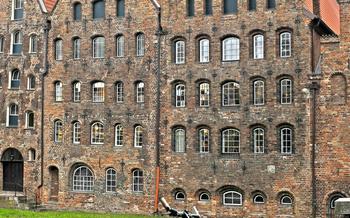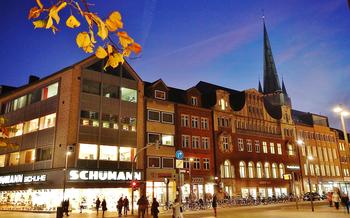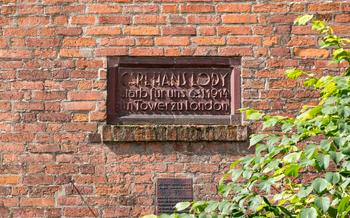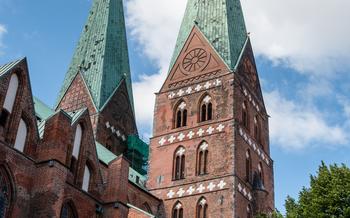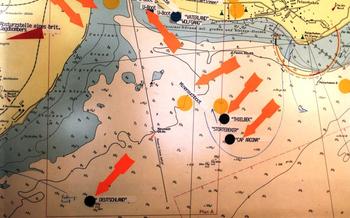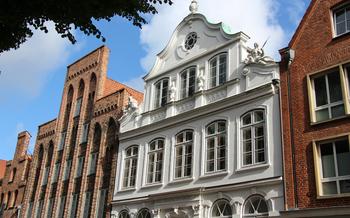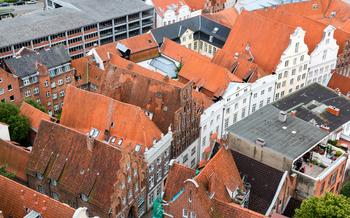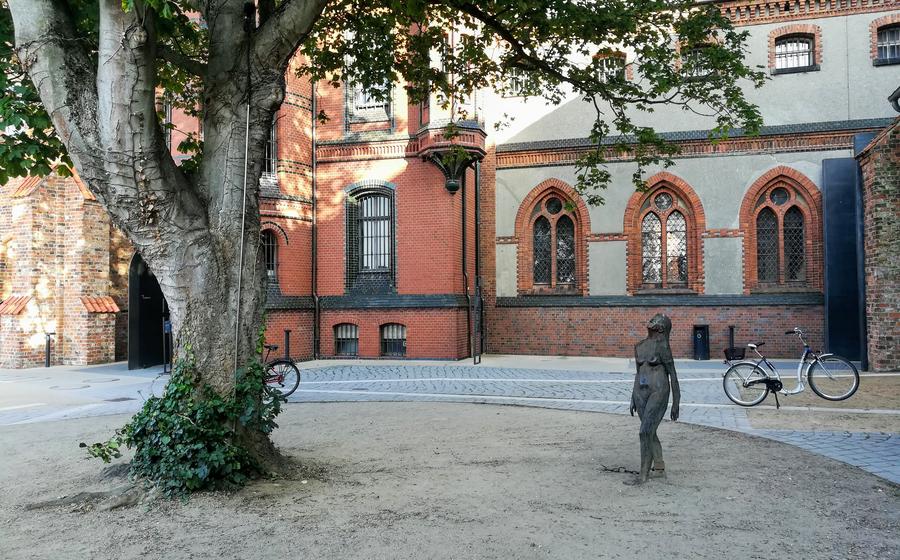
Domviertel
- Lübeck's Domviertel: A Historical Gem in the Hanseatic City
- Lübeck Cathedral: A Symbol of Hanseatic Power
- Marienkirche: A Masterpiece of Brick Gothic
- Buddenbrookhaus: A Literary Haven
- St. Anne's Museum: A Showcase of Medieval Art
- Heiligen-Geist-Kirche: A Hidden Gem
- St. Petri Church: A Symbol of Resilience
- Insider Tip: Join a guided tour of St. Petri Church to learn more about its fascinating history and architecture.
- Burgtor: A Gateway to the Past
- Koberg: A Picturesque Square
- Glockengießermuseum: A Chime Through Time
- St. Jakobi Church: A Place of Worship and Culture
- Museum of Nature and the Environment: A Journey Through Nature
- Willy-Brandt-Haus: A Tribute to a Statesman
- Insider Tip: Explore the Domviertel at Night
Lübeck's Domviertel: A Historical Gem in the Hanseatic City
The Domviertel, or Cathedral Quarter, is the historic heart of Lübeck, a city in northern Germany with a rich history and cultural heritage. This charming neighborhood is home to a wealth of architectural marvels, cultural attractions, and must-see landmarks that showcase the city's significance as a former member of the powerful Hanseatic League.
Historical Significance Lübeck's Domviertel has been at the center of the city's development since the Middle Ages. The construction of Lübeck Cathedral, a symbol of Hanseatic power, marked the beginning of the district's importance. Over the centuries, the Domviertel flourished as a religious, political, and economic hub, attracting merchants, traders, and artisans from across Europe.
Architectural Marvels The Domviertel is renowned for its stunning architecture, a testament to the city's wealth and prosperity during the Hanseatic period. Brick Gothic buildings, with their intricate facades and towering spires, dominate the district, creating a unique and picturesque cityscape. Notable examples include Lübeck Cathedral, the Marienkirche, and the Holy Spirit Hospital.
Cultural Attractions In addition to its architectural treasures, the Domviertel is home to a variety of cultural attractions that offer visitors a glimpse into Lübeck's rich history and heritage. Museums, art galleries, and historical sites abound, catering to diverse interests and providing a deeper understanding of the city's past.
Must-See Landmarks Among the must-see landmarks in the Domviertel are Lübeck Cathedral, with its impressive Gothic architecture and stunning interiors; the Marienkirche, a masterpiece of Brick Gothic with its intricate carvings and panoramic views; and the Buddenbrookhaus, a literary haven dedicated to the Nobel Prize-winning author Thomas Mann.
These attractions, along with many others, make the Domviertel a captivating destination for history buffs, architecture enthusiasts, and culture seekers alike. Whether you're strolling through its cobblestone streets, admiring its magnificent buildings, or delving into its rich history, the Domviertel promises an unforgettable experience.
Lübeck Cathedral: A Symbol of Hanseatic Power
Lübeck Cathedral, officially the Cathedral of the Holy Trinity, is not only a stunning example of Gothic architecture but also a symbol of the city's former power and wealth as a leading member of the Hanseatic League. Constructed over several centuries, starting in the 12th century, the cathedral showcases a harmonious blend of Romanesque and Gothic styles.
Historical Significance With roots dating back to the 12th century, Lübeck Cathedral bears witness to the city's rich history. It served as the religious center of the Hanseatic League, a powerful alliance of trading cities that dominated Northern Europe for centuries. The cathedral was a symbol of Lübeck's economic and political prowess, reflecting the city's prominent role in the Hanseatic network.
Architectural Marvels The cathedral's impressive exterior is a testament to the skill and artistry of medieval builders. Its grand façade features intricate carvings, delicate tracery, and towering spires that dominate the cityscape. Inside, the cathedral's vast interior awes visitors with its soaring vaults, elegant pillars, and intricate stained-glass windows.
Stunning Interiors Lübeck Cathedral's interior is as captivating as its exterior. The spacious nave, with its rows of slender columns, leads to the impressive high altar, a masterpiece of Gothic art. The cathedral is adorned with exquisite works of art, including paintings, sculptures, and intricate carvings that depict biblical scenes and stories.
Guided Tours To fully appreciate the cathedral's history, architecture, and art, guided tours are highly recommended. Knowledgeable guides provide insights into the cathedral's construction, its role in Lübeck's history, and the significance of its many features. Visitors can marvel at the intricate details and learn about the symbolism behind the various elements of the cathedral's design.
Marienkirche: A Masterpiece of Brick Gothic
Unique brickwork: The Marienkirche is a testament to the skill and artistry of medieval bricklayers. Its intricate brickwork, known as "opus latarum," is a distinctive feature that sets it apart from other Gothic churches. The exterior walls are adorned with elaborate patterns and designs, creating a mesmerizing visual effect.
Impressive towers: The Marienkirche boasts two impressive towers that dominate the Lübeck skyline. The south tower, known as the "Turm der Marienkirche," is the taller of the two, reaching a height of 125 meters. It offers breathtaking panoramic views of the city and the surrounding countryside.
Intricate carvings: The Marienkirche is adorned with a wealth of intricate carvings that showcase the exceptional craftsmanship of medieval artisans. These carvings depict religious scenes, mythical creatures, and everyday life, adding depth and character to the church's interior.
Panoramic views: Visitors can climb to the top of the south tower for breathtaking panoramic views of Lübeck and the surrounding region. The tower offers a unique perspective on the Domviertel, revealing the intricate details of the Marienkirche's roof and the surrounding cityscape.
Buddenbrookhaus: A Literary Haven
In the heart of Lübeck's Domviertel, nestled amidst centuries-old buildings, lies the Buddenbrookhaus, a literary gem that transports visitors back to the world of Thomas Mann's renowned novel, "Buddenbrooks." This magnificent patrician house, once home to the Buddenbrook family, has been meticulously transformed into a museum dedicated to the life and works of the Nobel laureate.
Stepping into the Buddenbrookhaus is like stepping into a time capsule, where the opulent lifestyle of the Buddenbrooks comes alive. The grand reception rooms, adorned with intricate stuccowork and gleaming chandeliers, evoke the grandeur of the Hanseatic era. Visitors can wander through the meticulously preserved living quarters, imagining the family's daily life, their triumphs, and their struggles.
The museum's exhibits delve deep into the world of Thomas Mann, shedding light on his creative process and the inspirations behind his literary masterpieces. Manuscripts, first editions, and personal belongings provide a glimpse into the mind of a writer who captured the essence of Lübeck and its people. Guided tours led by knowledgeable experts offer insights into Mann's life, his writing, and the historical context that shaped his work.
For literature enthusiasts, a visit to the Buddenbrookhaus is a pilgrimage to a sacred site. It is a place to immerse oneself in the world of the Buddenbrooks, to understand the genius of Thomas Mann, and to appreciate the enduring power of storytelling.
St. Anne's Museum: A Showcase of Medieval Art
Step into the fascinating world of medieval art at St. Anne's Museum, housed within the former St. Anne's Monastery. This remarkable institution boasts an extensive collection of medieval artifacts, providing a glimpse into the rich artistic heritage of Lübeck.
Marvel at the intricate wood carvings and sculptures that adorn the museum's walls, each piece a testament to the skill and artistry of medieval craftsmen. Explore the collection of religious paintings and tapestries, which depict biblical scenes and the lives of saints with stunning detail.
Don't miss the museum's rotating exhibitions, which showcase a variety of medieval-themed topics. From the history of bookbinding to the development of medieval weaponry, there's always something new to discover at St. Anne's Museum.
Join a guided tour to delve deeper into the museum's collection and learn about the fascinating stories behind the artifacts. Discover the symbolism and techniques used by medieval artists, and gain a deeper appreciation for the enduring legacy of medieval art.
Heiligen-Geist-Kirche: A Hidden Gem
Nestled amidst the bustling streets of Lübeck's Domviertel, the Heiligen-Geist-Kirche stands as a testament to the city's rich architectural heritage. This hidden gem, often overlooked by visitors, offers a serene sanctuary for those seeking tranquility and artistic beauty.
Constructed in the 13th century, the Heiligen-Geist-Kirche exudes an aura of medieval charm. Its Gothic architecture, characterized by pointed arches, ribbed vaults, and flying buttresses, transports visitors back in time. The church's exterior is adorned with intricate carvings and sculptures, depicting biblical scenes and mythical creatures.
Step inside the Heiligen-Geist-Kirche, and be captivated by its stunning stained-glass windows. These vibrant masterpieces, crafted by skilled artisans, depict religious narratives and illuminate the interior with a kaleidoscope of colors. The soft light filtering through the windows creates a mystical atmosphere, inviting contemplation and serenity.
In contrast to its ornate exterior, the interior of the Heiligen-Geist-Kirche is characterized by a sense of simplicity and elegance. The whitewashed walls, devoid of elaborate decorations, draw attention to the church's architectural features. The nave, with its soaring vaulted ceiling, creates a sense of spaciousness and grandeur.
The Heiligen-Geist-Kirche is not only a place of worship but also a venue for cultural events. Regular concerts, exhibitions, and lectures are held within its hallowed walls, offering visitors an opportunity to experience the church's acoustics and artistic heritage.
Whether you seek spiritual solace, artistic inspiration, or simply a moment of tranquility, the Heiligen-Geist-Kirche is a hidden gem that should not be missed. Take a step into this medieval sanctuary and let its beauty and serenity envelop you.
St. Petri Church: A Symbol of Resilience
A Towering Testimony to Lübeck's Enduring Spirit
In the heart of Lübeck's Domviertel stands St. Petri Church, a striking Gothic edifice that has witnessed centuries of history. Its towering spires reach towards the heavens, a testament to the resilience of the Hanseatic city. Remarkably, St. Petri Church emerged relatively unscathed from the devastating air raids of World War II, while much of Lübeck lay in ruins. This remarkable feat of survival has earned it the title of "the miracle church."
Step inside the church, and you'll be captivated by its stunning interiors. The soaring vaults, intricate carvings, and magnificent stained-glass windows create an atmosphere of awe and reverence. Climb the narrow spiral staircase to the top of the church tower, and you'll be rewarded with breathtaking panoramic views of Lübeck and the surrounding countryside. Take a moment to savor the vista, and reflect on the rich history that unfolds beneath you.
Insider Tip: Join a guided tour of St. Petri Church to learn more about its fascinating history and architecture.
Burgtor: A Gateway to the Past
Lübeck's Domviertel is home to several medieval gatehouses, but none as impressive as the Burgtor. Located on the eastern edge of the district, this imposing structure served as a defensive fortification during the city's turbulent past. Its massive towers, intricate brickwork, and portcullis evoke a sense of grandeur and resilience.
The Burgtor was constructed in the 15th century as part of Lübeck's fortifications. It guarded the entrance to the city from the east and played a crucial role in defending against attacks. The gatehouse features two massive towers that flank a central archway, creating a formidable barrier. The towers are adorned with decorative brickwork and crenellated parapets, adding to their imposing appearance.
Over the centuries, the Burgtor has undergone several renovations and modifications. However, it has retained its original medieval character and remains a testament to Lübeck's rich history. Today, the gatehouse serves as a popular tourist attraction, offering visitors a glimpse into the city's past.
Visitors to the Burgtor can explore the interior of the gatehouse and climb the towers for stunning views of the Domviertel and beyond. Guided tours are available, providing insights into the history and significance of this architectural gem.
Koberg: A Picturesque Square
Koberg is the heart of Lübeck's Domviertel, a picturesque square surrounded by historical buildings, charming cafes, and lively restaurants. The square derives its name from the Koberg Monastery, which once stood on this site. Today, Koberg is a popular gathering spot for locals and visitors alike, offering a vibrant atmosphere and a glimpse into Lübeck's rich history.
Historical Significance
Koberg has been a central part of Lübeck's urban fabric since the Middle Ages. In the 13th century, the square was expanded and became a market square. Over the centuries, Koberg witnessed many significant events, including the construction of the Marienkirche and the Holy Spirit Hospital. In the 19th century, the square was redesigned with the addition of trees and park benches, transforming it into a popular recreational area.
Architectural Marvels
The buildings surrounding Koberg showcase a variety of architectural styles, from Gothic to Renaissance to Baroque. Among the most notable buildings are the Marienkirche, the Holy Spirit Hospital, and the Town Hall. The Marienkirche, with its towering spires and intricate brickwork, is a masterpiece of Gothic architecture. The Holy Spirit Hospital, with its grand facade and beautiful courtyard, is a fine example of Renaissance architecture. The Town Hall, with its elegant Renaissance design, is a symbol of Lübeck's civic pride.
Cultural Attractions
Koberg is home to several cultural attractions, including the Buddenbrookhaus and the St. Anne's Museum. The Buddenbrookhaus is a museum dedicated to the life and work of Nobel laureate Thomas Mann, who was born in Lübeck. The museum offers a glimpse into the world of the Buddenbrook family, the inspiration for Mann's famous novel "Buddenbrooks." The St. Anne's Museum houses a collection of medieval art, including paintings, sculptures, and artifacts. The museum also hosts rotating exhibitions, offering visitors a chance to explore a variety of artistic styles and periods.
Must-See Landmarks
When visiting Koberg, be sure to see the following landmarks:
- Marienkirche: A stunning example of Gothic architecture, with its towering spires and intricate brickwork.
- Holy Spirit Hospital: A beautiful Renaissance building with a grand facade and a peaceful courtyard.
- Town Hall: An elegant Renaissance building that is a symbol of Lübeck's civic pride.
- Buddenbrookhaus: A museum dedicated to the life and work of Nobel laureate Thomas Mann.
- St. Anne's Museum: A museum housing a collection of medieval art, including paintings, sculptures, and artifacts.
Glockengießermuseum: A Chime Through Time
Delve into the fascinating world of bell casting at the Glockengießermuseum, a unique museum dedicated to the art and history of bell making. Located in the heart of the Domviertel, this museum offers an immersive experience that will captivate visitors of all ages.
Explore interactive exhibits that showcase the intricate process of bell casting, from the initial design to the final pouring of molten metal. Learn about the different techniques and materials used in bell making, and discover the secrets behind the beautiful sounds that bells produce.
The museum's collection boasts a diverse range of bells, from tiny handbells to massive church bells. Admire the craftsmanship and artistry that goes into each bell, and listen to the unique sounds they make when struck.
Join a guided tour to gain insights into the history of bell casting in Lübeck and the role that bells have played in the city's cultural and religious life. Discover how bells were used to mark time, signal events, and protect against evil spirits.
Whether you're a history buff, a music lover, or simply curious about the art of bell making, the Glockengießermuseum is a must-visit attraction in the Domviertel. Prepare to be mesmerized by the beauty and history of these timeless instruments.
St. Jakobi Church: A Place of Worship and Culture
A Spiritual and Cultural Haven
St. Jakobi Church, an architectural gem located in the heart of Lübeck's Domviertel, stands as a testament to the city's rich religious and cultural heritage. Its Gothic spires pierce the sky, beckoning visitors to delve into its sacred spaces and explore its vibrant cultural offerings.
Gothic Grandeur
Constructed in the 13th century, St. Jakobi Church showcases the exquisite craftsmanship and architectural prowess of the Gothic era. Its towering nave, intricate rib vaults, and graceful pointed arches create an awe-inspiring atmosphere that transports visitors back in time. The church's exterior is adorned with intricate carvings and sculptures, depicting biblical scenes and saints, adding a layer of visual intrigue to its imposing facade.
Contemporary Art Meets History
In a unique blend of the sacred and the contemporary, St. Jakobi Church has embraced modern art as a means to engage with visitors and foster cultural dialogue. The church's interior hosts rotating exhibitions showcasing works by renowned contemporary artists, juxtaposing the historical grandeur of the space with thought-provoking modern interpretations.
Music and Cultural Events
St. Jakobi Church is not merely a place of worship but also a vibrant cultural hub. Throughout the year, the church hosts a diverse range of concerts, performances, and cultural events, attracting locals and visitors alike. From classical music recitals to contemporary dance performances, the church's acoustics and intimate atmosphere provide a unique backdrop for cultural experiences.
Guided Tours and Spiritual Reflections
Visitors can embark on guided tours of St. Jakobi Church to gain insights into its history, architecture, and cultural significance. Knowledgeable guides lead visitors through the church's sacred spaces, shedding light on its religious traditions and the stories behind its remarkable artworks. Whether seeking spiritual solace, cultural enrichment, or a blend of both, St. Jakobi Church offers a sanctuary for contemplation and exploration.
Museum of Nature and the Environment: A Journey Through Nature
Located in the heart of the Domviertel, the Museum of Nature and the Environment invites visitors to embark on a captivating journey through the natural world. This fascinating museum houses a wealth of exhibits that showcase the diverse flora and fauna of the region, providing an immersive experience for nature enthusiasts of all ages.
Step inside and be greeted by interactive displays that bring the natural world to life. Explore the intricate relationships between species and their habitats, and gain insights into the ecological challenges facing our planet. Learn about the unique ecosystems of the Baltic Sea and discover the fascinating creatures that call it home.
The museum also features a collection of fossils and minerals, offering a glimpse into the Earth's ancient past. Visitors can marvel at the remains of prehistoric animals and plants, and learn about the geological processes that have shaped our planet over millions of years.
Whether you're a budding naturalist or simply curious about the natural world, the Museum of Nature and the Environment is a must-visit attraction in Lübeck. Interactive exhibits, educational programs, and guided tours make this museum a perfect destination for families, school groups, and anyone interested in exploring the wonders of the natural world.
Willy-Brandt-Haus: A Tribute to a Statesman
In the heart of Lübeck's Domviertel, nestled amidst centuries-old buildings, stands the Willy-Brandt-Haus, a testament to the legacy of one of Germany's most influential statesmen. Once the home of Willy Brandt, the former Chancellor of West Germany and Nobel Peace Prize laureate, the Willy-Brandt-Haus has been transformed into a museum dedicated to his life and achievements.
Through interactive exhibits and historical artifacts, visitors can delve into the remarkable journey of Willy Brandt, from his humble beginnings to his rise as a prominent figure in German politics. The museum showcases his pivotal role in shaping West Germany's foreign policy, particularly his Ostpolitik, which aimed to improve relations with Eastern Bloc countries during the Cold War.
Visitors can explore Brandt's personal belongings, including his iconic eyeglasses and the desk where he worked tirelessly to promote peace and reconciliation. The museum also hosts temporary exhibitions that shed light on different aspects of Brandt's life and work, as well as his enduring impact on German history.
Guided tours are available to provide visitors with a deeper understanding of Brandt's political career and his contributions to German society. The Willy-Brandt-Haus stands as a reminder of his unwavering commitment to democracy, human rights, and international cooperation, leaving a lasting legacy that continues to inspire generations.
Insider Tip: Explore the Domviertel at Night
As the sun sets over the Domviertel, a magical transformation takes place. The streets, once bustling with activity, become eerily quiet, and the historic buildings cast long shadows across the cobblestone lanes. This is the perfect time to explore the Domviertel and experience its unique charm.
Stroll through the quiet streets and admire the illuminated landmarks. The Gothic spires of Lübeck Cathedral and Marienkirche seem to reach for the stars, while the Burgtor casts a warm glow over the surrounding area. Take your time to soak in the beauty of these architectural marvels and capture stunning nighttime photographs.
If you're lucky, you might even catch a glimpse of the Domviertel's resident ghost, the "Grauer Mönch" (Gray Monk). According to legend, this ghostly figure haunts the streets of the Domviertel, searching for redemption for his past sins.
To truly immerse yourself in the Domviertel's nocturnal atmosphere, join a guided night tour. These tours offer a unique perspective on the district's history and legends, and they're a great way to learn more about the Domviertel's hidden secrets.
Whether you choose to explore the Domviertel on your own or with a guide, be sure to take advantage of the opportunity to experience its magic after dark.
